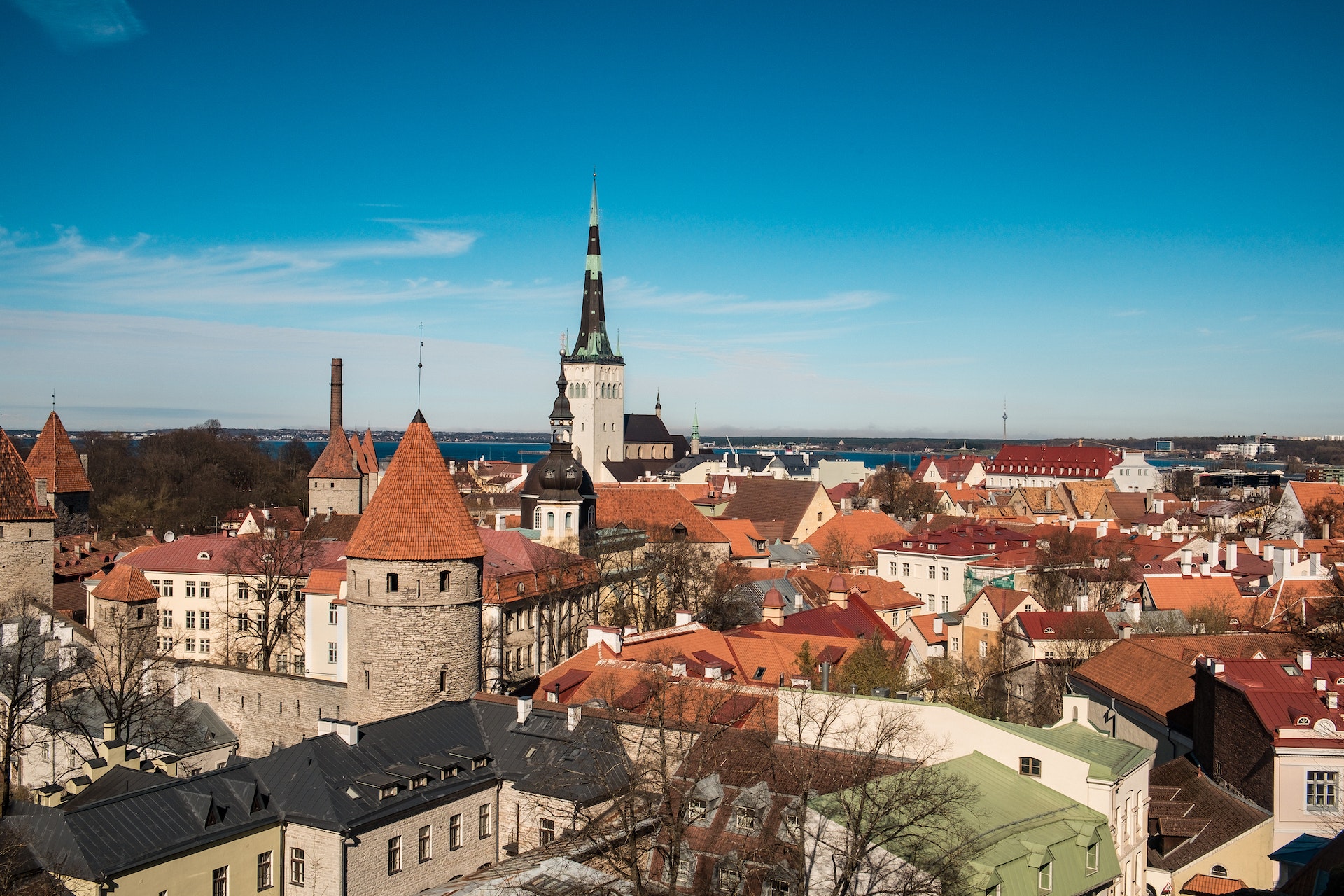If you plan to travel to Estonia or want to learn the Estonian language, then this article is the perfect starting point. You’ll find some essential Estonian words and phrases here that are useful to know, no matter what your goal for learning Estonian might be.
Having a grasp of useful Estonian expressions can greatly enhance your travel experience and give you valuable knowledge about the country’s culture and traditions. Additionally, these phrases can lead to great conversations and foster connections with the locals.
If you mostly plan to spend your time in Tallinn, then you’ll find that almost everyone among the younger generations can speak English, but if you venture out of Tallinn and Harju County, then it might be useful to know some Estonian to help you communicate with the locals.

Learn with Lingvist now
Greetings and Farewells in Estonian
Estonians don’t expect foreigners to understand or speak their language, so learning and using even some basic Estonian is going to make them happy, although they might not express it. Let’s start with some greetings and goodbyes.
Tere – Hello. This is the most common way of greeting someone in Estonian and can be used both formally and informally.
Tervist – Hello. A less formal greeting, so it’s better to use it when you’ve met the person before. When you say “Tervist,” you’re literally wishing someone health.
Hei – Hey. Even less formal than “Tervist.”
Nägemist – Goodbye.
Head aega – Goodbye.
Tšau – Ciao. Used with people who you know as both a greeting and a goodbye. The correct way of writing it is “Tšau,” but when you see Estonians type this word, then you’ll very rarely see someone use the correct form, since it’s easier just to write “Tsau.”
Examples: Tšau, kuidas läheb? – Hey, how are you doing?
Ma hakkan siis minema. Tšau! – I’ll get going then. Bye!
Tšauki – A cuter way of saying “Tšau.”
Homseni – Until tomorrow. You can use this when you know that you’ll see this person tomorrow.
Järgmise korrani – Until next time
Kohtumiseni – Until next time. The literal meaning is “Until (we) meet.”
Nägudeni – Until next time. The literal translation is “Until faces.”
Pakaa – Bye. More slangish-sounding and borrowed from Russian. Example: Tšau, pakaa, varsti näeme! – Bye, see you soon!
Meeldiv tutvuda – Nice to meet you. Literally “Nice to get familiar / get to know you.”
Meeldiv kohtuda – Nice to meet you.
Greetings and goodbyes for different times of day
Tere hommikust – Good morning
Hommikust/Hommik – Morning. These are less formal greetings than “Tere hommikust,” so they’re used among people who know each other.
Tere päevast – Good day.
Tere õhtust – Good evening.
Head ööd – Good night (before going to bed).
Kena päeva / Head päeva – Have a nice day.
Head õhtut / Kena õhtut – Have a nice evening.
Secondary greetings
These questions follow the first greeting if you’re familiar with the person you’re talking to and want to know how they are doing or have been lately.
Kuidas (sul) läheb? – How are you doing? How is it going? “Sul” can be omitted.
This phrase is only used with people whom you already know and never with strangers. That’s because unlike English it isn’t a greeting but more of a conversation starter. People would usually answer with “Hästi” (Well), but they can go more in depth with their response as well.
Kuidas sul läinud on? – How have you been doing?
Hästi – Well.
Päris hästi – Quite well.
Pole viga – Not bad.
Nii ja naa – So so.
Mis teed? – Whatcha doin’? This is a friendly phrase to use with friends.
Pole ammu näinud – Long time no see.
Millega sa viimasel ajal tegelenud oled? – What have you been up to lately?

Getting to know each other
Mis teie nimi on? – What is your name? This is a formal way of asking.
Mis sinu nimi on? – What is your name?
Minu nimi on… – My name is…
Kust te pärit olete? – Where are you from? This is a formal way of asking.
Kust sa pärit oled? – Where are you from?
Ma olen pärit… – I am from…
Soomest – from Finland
Venemaalt – from Russia
Lätist – from Latvia
Leedust – from Lithuania
Rootsist – from Sweden
Norrast – from Norway
Islandilt – from Iceland
Saksamaalt – from Germany
Prantsusmaalt – from France
Austraaliast – from Australia
Ameerika Ühendriikidest – from the US
Uus-Meremaalt – from New Zealand
Maybe you noticed that in these examples the country name sometimes ended with -st and other times -lt. This is because of the Estonian grammatical cases, which you can read more about later in this article.
Mis sul täna veel plaanis on? – What else do you have planned for today?
Ma plaanin minna… – I plan to go…
Kinno – to the cinema
Peole – to a party
Klubisse – to a club
Teatrisse – to the theater
Ooperisse – to the opera
Randa – to the beach
Jalutama – for a walk
Metsa – to the forest
Do you speak…?
Kas te räägite inglise keelt? – Do you speak English? (formal)
Kas sa räägid inglise keelt? – Do you speak English? (informal)
Vabandust, ma ei oska eesti keelt – Sorry, I don’t know Estonian.
Vabandust, ma ei räägi eesti keelt – Sorry, I don’t speak Estonian.
Vabandust, ma ei saa eesti keelest aru – Sorry, I don’t understand Estonian.
Ma saan aru, aga ei räägi – I understand but don’t speak.
Ma oskan ainult natuke eesti keelt – I know only a little Estonian.
Getting attention when you need help
Vabandage – Excuse me. This is for getting someone’s attention or apologizing.
Vabandust – I’m sorry. This is how you say “Sorry” in Estonian. It can also be used as “Excuse me,” but “Vabandage” is more common in that case.
Kas te saaksite mind palun aidata? – Could you help me, please?
Appi! – Help! This is in case of an emergency.
Kutsuge kiirabi – Call the ambulance.
Kutsuge politsei – Call the police.
Kutsuge tuletõrje – Call the fire department.
Ordering a taxi in Estonia
Now that taxis can be ordered using apps like Bolt, you don’t really need to talk to taxi drivers that much anymore. Usually, it’s enough if you say “Tere” at the beginning of the ride and “Aitäh ja head aega” at the end of the ride. However, in case you need to give your taxi driver some more instructions, we’ve listed some useful sentences and phrases here.
Ma lähen… – I’m going to…
Kas saate mind viia… – Could you take me to…
And both of these sentences could be followed with:
Vabaduse väljakule – to Freedom Square
Tallinna ülikooli – to Tallinn University
Kultuurikatlasse – to Kultuurikatel
Lauluväljakule – to the Song Festival Grounds
Teletorni – to the TV Tower
Balti jaama – to Balti Station
[Street name], palun – [Street name], please.
Example: Pärnu maantee 10 (kümme), palun – Pärnu Highway 10, please.
At a cafe or restaurant
Ma sooviksin tellida… – I would like to order…
Ma võtaksin … – I would take…
These sentences can be followed with:
Kohvi – Some coffee
Ühe kohvi – One coffee
Kaks kohvi – Two coffees
Teed – Some tea
Ühe tee – One tea
Kaks teed – Two teas
Vett – Some water
Ühe vee – One water
Kaks vett – Two waters
Üks kohv/tee/vesi, palun – One coffee/tea/water, please.
Ma võtaks tüki seda kooki – I would take a piece of this cake.
Kas gaasiga või ilma gaasita? – Sparkling or still (water)?
And you can simply answer with:
Gaasiga – Sparkling
Ilma (gaasita) – Still
Ma sooviksin maksta – I would like to pay.
Kas ma saaksin arve? – Could I get the bill?
Kas kaardiga või sulas? – By card or in cash?
Kaardiga – by card
Sulas – in cash
Being Polite
Here are some phrases you can use in cafes and restaurants.
Selecting something to order
Ma võtaks selle – I would take this.
Ma võtaks seda – I would take some of this.
The difference between these two sentences is that when using “selle” you imply that you take the whole of something, such as a whole cake, for example. “Seda” is used when you would take “some” of something, like some salad or some cake.
See siin – This one.
See seal – That there.
Mitte see – Not that one.
Yes, please / No, thank you
When visiting Estonia, you might need to use these sentences in shops when the cashier is asking whether you want a bag or a receipt: “Kas te kotti soovite?” – Would you like a bag? “Kas tšekki on vaja?” – Do you need a receipt?
Jah, palun – Yes, please.
Ei, tänan / Ei, aitäh – No, thank you.
Pole vaja – No need. This is the same kind of response as “Ei, tänan” or “Ei, aitäh” but sounds a little less formal, though it’s still OK to use it when responding to strangers.
This was great/delicious
See oli suurepärane – This was great.
See oli väga maitsev – This was delicious.
See on nii maitsev – It’s so delicious.
See ei olnud väga maitsev – It wasn’t that tasty.
Head isu – Enjoy your meal. Literally, “Good appetite.”
Jätku leiba / Jätku leivale – Enjoy your meal. The literal translation is something like “Let the bread continue.” Nowadays it’s more common with the older generation, so you won’t hear it that often. The answer to this phrase would be “Jätku tarvis,” which is a way to thank the person and literally means “Continuation needed.”
Continue learning Estonian with Lingvist
These basic words and phrases will help you navigate daily interactions with Estonian speakers and keep building your language skills. However, to take your Estonian studies to the next level, you should continue learning with Lingvist, which has a full Estonian course with over 3000 of the most common Estonian words. You can get started right away and take advantage of a free trial. Jõudu tööle! (Literally “Strength for the work,” an Estonian phrase used to encourage someone in their efforts).

